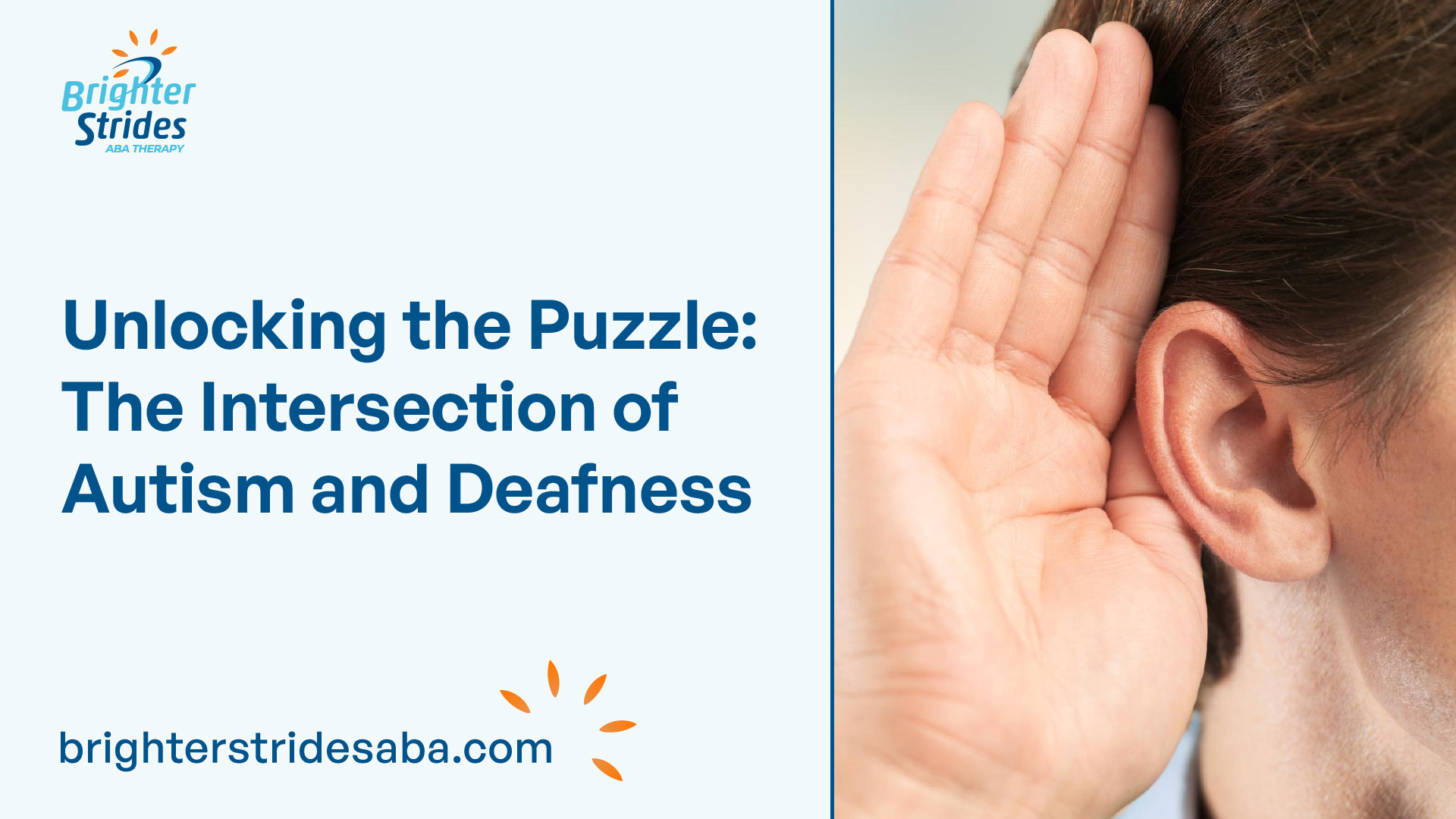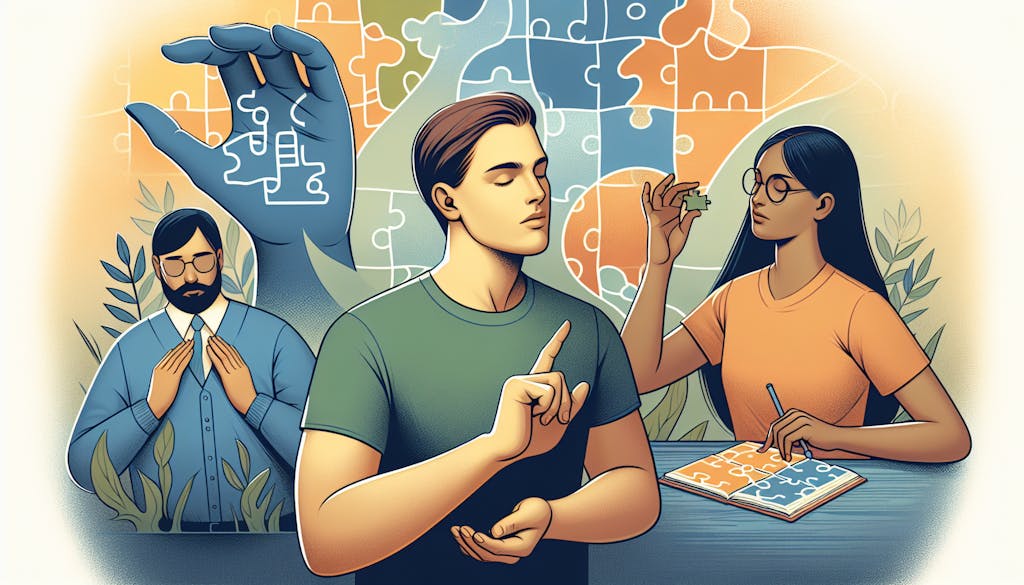Understanding the Connection
When it comes to the intersection of autism and deafness, there is a significant connection that researchers and professionals have been exploring. Understanding this connection is essential for providing appropriate support and interventions for individuals who experience both conditions.
Co-Occurrence Statistics
Studies have shown that there is a higher co-occurrence of autism and deafness compared to the general population. During the 2009-2010 school year, it was estimated that around 1 in 59 children with hearing loss, specifically 8-year-olds in the US, were also receiving services for autism, which is higher than the reported national estimates for hearing children. This suggests that there is an increased likelihood of autism among individuals with hearing loss.

Autism occurs in an estimated 4 to 9 percent of deaf or hard-of-hearing children, in contrast to only 1 percent of children in the general population. This significant disparity highlights the need for further research and understanding of the relationship between these two conditions.
Impact of Hearing Loss Severity
The severity of hearing loss has also been found to play a role in the co-occurrence of autism. Children with profound hearing loss have been found to have a higher incidence of a comorbid diagnosis of autism compared to those with milder forms of hearing loss. This suggests that the severity of hearing loss may contribute to the likelihood of autism being present alongside deafness.
It is worth noting that approximately half of autistic children have at least one kind of peripheral hearing problem, compared to only 15 percent of typical peers. This indicates that there may be shared underlying factors between autism and hearing difficulties.
The impact of hearing loss severity on the co-occurrence of autism and deafness is an area that requires further investigation. By better understanding this connection, researchers and professionals can develop more targeted interventions and support strategies to address the unique needs of individuals with both conditions.
Challenges Faced
Individuals who are both autistic and deaf face unique challenges that arise from the intersection of these two conditions. These challenges can impact various aspects of their lives, including communication, social interaction, and sensory processing.
Communication Barriers
Communication difficulties are a significant challenge for individuals with both autism and deafness. The combination of these conditions can compound the difficulties these individuals face in understanding and using language effectively. Autism can affect the development of language skills, while deafness presents additional barriers to verbal communication. This can make it challenging for individuals to express their thoughts, needs, and emotions, as well as understand others.
Social Interaction Difficulties
Individuals with both autism and deafness may experience significant challenges when it comes to social interaction. Both conditions can make it difficult for individuals to connect with others and understand social cues. Autism can impact social communication and the ability to recognize and respond appropriately to social cues, while deafness can limit access to auditory social information. These challenges can lead to feelings of isolation and difficulty forming meaningful relationships.
Sensory Processing Variances
Sensory issues are common in individuals with both autism and deafness. Autism is often associated with sensory sensitivities, where individuals may be hypersensitive to certain sensory input. On the other hand, individuals who are deaf rely heavily on visual or tactile input. The combination of these conditions can lead to unique challenges in processing sensory information. Individuals may experience difficulty filtering and integrating sensory stimuli from their environment, which can impact their daily functioning and overall well-being.
Addressing the challenges faced by individuals who are both autistic and deaf requires a comprehensive and individualized approach. By understanding and addressing their specific needs, it is possible to provide the necessary support and interventions to enhance their quality of life.
Best Practices and Approaches
When it comes to supporting individuals with the dual challenges of autism and deafness, there are specific best practices and approaches that can greatly enhance their quality of life and facilitate their development.
Bilingual-Bicultural Approach
A recommended approach for individuals with autism and deafness is the bilingual-bicultural approach. This approach acknowledges and embraces both deaf culture and the autism community, incorporating sign language as a primary mode of communication. By recognizing and valuing the unique experiences and identities of individuals with autism and deafness, the bilingual-bicultural approach can foster a sense of belonging and facilitate effective communication [4].
Assistive Technology and Communication Devices
Assistive technology and communication devices play a vital role in supporting individuals with autism and deafness. These tools bridge communication gaps and facilitate interaction with the world around them. There are a variety of assistive technologies available, such as video conferencing platforms that facilitate communication between individuals who are deaf and those who use sign language. Additionally, there are apps and software programs that provide visual or tactile feedback to help individuals regulate their sensory input. These technological advancements empower individuals with autism and deafness to communicate, socialize, and access information more effectively.
Individualized Education Plans (IEPs)
Individualized Education Plans (IEPs) are critical for individuals with autism and deafness. These plans outline specific goals, accommodations, and modifications to support their educational journey. Specialized services should also be incorporated into the individual’s support plan, such as occupational therapy, speech therapy, applied behavior analysis (ABA), and deaf education specialists. By tailoring educational strategies and interventions to meet the unique needs of individuals with autism and deafness, IEPs provide a roadmap for their academic success and overall development.
It is important to note that these approaches and practices should be implemented in a holistic and individualized manner, taking into consideration the specific strengths, challenges, and preferences of each individual with autism and deafness. By providing a supportive and inclusive environment, along with the appropriate tools and strategies, we can empower individuals with autism and deafness to thrive and reach their full potential.
Diagnostic Difficulties
When it comes to diagnosing individuals with both autism and deafness, there are unique challenges that clinicians and professionals encounter. These challenges stem from the complex nature of the diagnoses and the overlapping behaviors observed in individuals with both conditions.
Complex Diagnoses
Diagnosing individuals who are deaf and also have autism can be particularly complex. Clinicians often face difficulties distinguishing between the symptoms of autism and those related to hearing loss. This can lead to missed or incorrect diagnoses, potentially impacting the individual’s access to appropriate interventions and support.
Furthermore, diagnostic tests that are commonly used for typical children may not be suitable for deaf or hard-of-hearing children. This highlights the need for adapted diagnostic tools specifically designed to address the unique challenges faced by individuals with both autism and deafness. Clinicians and researchers are actively working on developing and refining these tools to improve diagnostic accuracy and outcomes in this population.
Overlapping Behaviors
Another diagnostic challenge arises from the overlapping behaviors observed in individuals with autism and deafness. These overlapping behaviors can make it difficult to distinguish between the effects of autism and the impact of hearing loss. This phenomenon, known as “diagnostic overshadowing,” can lead to delays in identifying autism or the misattribution of certain behaviors solely to deafness [5].
To address these diagnostic difficulties, professionals are exploring adapted assessments and evaluation measures specifically designed for individuals who are deaf or hard-of-hearing and may have autism. The combined use of the ADI-R Deaf adaptation and ADOS-2 Deaf adaptation has shown promise, achieving high specificity and minimizing false positives when diagnosing autism in deaf children.
To overcome these diagnostic challenges and achieve accurate diagnoses, an interdisciplinary approach is crucial. Assessments should involve professionals with expertise in audiology, speech/language pathology, psychology, education, and occupational therapy. This interdisciplinary team should consider the child’s language modality, fluency, and access to language when selecting and adapting assessment measures.
By recognizing and addressing the complex nature of diagnosing individuals with both autism and deafness, clinicians and professionals can improve diagnostic accuracy, leading to more effective interventions and support for these individuals.
Addressing Diagnostic Challenges
Diagnosing autism in individuals who are deaf or hard-of-hearing can be particularly challenging due to diagnostic overshadowing and limited validated assessment measures specifically designed for this population. However, there are strategies and tools available to address these diagnostic challenges and provide accurate assessments.
Screening and Diagnostic Tools
When it comes to diagnosing autism in individuals who are deaf or hard-of-hearing, it is crucial to use appropriate screening and diagnostic tools. Traditional diagnostic tests designed for typical children may not be suitable for those with hearing issues, potentially leading to missed or incorrect diagnoses.
One commonly used diagnostic tool is the Autism Diagnostic Observation Schedule, Second Edition (ADOS-2). However, it was not originally developed for children with sensory differences, such as deaf or hard-of-hearing children. Modifications have been made to the ADOS-2 for this population, including task and scoring adaptations, but further validation is still needed.
Another tool that shows promise is the Deaf-adapted ADOS-2, which specifically addresses the unique characteristics and communication needs of deaf and hard-of-hearing individuals. Additionally, adapted versions of the Autism Diagnostic Interview, Revised (ADI-R) have been developed, providing assessment options that consider the specific challenges faced by this population.
Interdisciplinary Assessment Approach
Due to the complexity of diagnosing autism in individuals who are deaf or hard-of-hearing, an interdisciplinary assessment approach is essential. This approach involves professionals from various fields, including audiology, speech/language pathology, psychology, education, and occupational therapy. Each professional brings their expertise to the assessment, considering factors such as language modality, fluency, and access to language when selecting and adapting assessment measures.
By combining the knowledge and perspectives of multiple professionals, a comprehensive understanding of the individual’s abilities, challenges, and communication needs can be obtained. This interdisciplinary approach improves the accuracy of the diagnosis, ensuring that the unique characteristics of autism and deafness are properly considered.
Addressing diagnostic challenges in individuals with autism and deafness requires the use of appropriate screening and diagnostic tools, as well as an interdisciplinary assessment approach. Continued research and development of adapted assessment measures are needed to enhance the accuracy and reliability of autism diagnoses in this population. By employing these strategies, clinicians can provide accurate diagnoses and tailor interventions to meet the specific needs of individuals with autism and deafness.
Supporting Individuals
Supporting individuals who experience the intersection of autism and deafness requires a comprehensive approach that addresses their unique needs. Here are some strategies and considerations for promoting emotional resilience, effective communication, and overall wellbeing.
Emotional Resilience and Wellbeing
Autism, like deafness, is not a mental health issue, but individuals with both autism and deafness can face challenges with emotional health and wellbeing. It is essential to be aware of the risks and take steps to develop emotional resilience and wellbeing.
Supporting emotional resilience involves creating a safe and supportive environment where individuals feel understood and validated. This can be achieved through:
- Providing access to mental health professionals who have expertise in working with individuals who are deaf and autistic.
- Encouraging self-expression through art, music, or other creative outlets.
- Promoting self-advocacy skills to help individuals communicate their needs effectively.
- Establishing routines and predictable structures to reduce anxiety and promote a sense of security.
Social Stories and Comic Strip Conversations
Social stories and comic strip conversations are effective tools for individuals with autism and deafness. These visual supports provide short descriptions of situations, events, or activities, including information about what to expect and why. They help to develop greater social understanding and ensure safety.
Social stories use written or visual narratives to explain social situations, social cues, and appropriate responses. Comic strip conversations use simple illustrations and speech bubbles to depict conversations and social interactions. These resources can aid in comprehension, promote appropriate social behavior, and reduce anxiety in social settings.
Importance of Emotional Health
It is crucial to prioritize emotional health when supporting individuals who are both deaf and autistic. All behavior is a form of communication, and it is essential to understand that what may be perceived as “difficult” or “challenging” behavior is often an expression of an unmet need rather than intentional misbehavior. By recognizing and addressing these unmet needs, individuals can develop healthier coping mechanisms and emotional regulation skills.
Supporting emotional health involves:
- Providing access to appropriate therapeutic interventions, such as cognitive-behavioral therapy or play therapy, tailored to the individual’s needs.
- Encouraging the development of self-calming strategies, such as deep breathing exercises or sensory-based activities.
- Promoting self-care practices, including physical exercise, healthy sleep patterns, and a balanced diet.
- Fostering positive relationships and social connections to reduce feelings of isolation and promote a sense of belonging.
By prioritizing emotional resilience and wellbeing, individuals with the intersection of autism and deafness can thrive and lead fulfilling lives. It is crucial to provide a supportive environment that acknowledges their unique challenges and empowers them to navigate social interactions and emotions successfully.
References
- https://pubmed.ncbi.nlm.nih.gov/22290585/
- https://www.spectrumnews.org/features/deep-dive/confusion-at-the-crossroads-of-autism-and-hearing-loss/https://totalcareaba.com/
- https://www.astraaba.com/blog/autism-and-deafness
- https://www.yellowbusaba.com/post/autism-and-deafness
- https://www.ncbi.nlm.nih.gov/pmc/articles/PMC10271818/
- https://www.ndcs.org.uk/information-and-support/childhood-deafness/additional-needs/deafness-and-autism/

 We've just released an article!
Check out our blog!
We've just released an article!
Check out our blog!



